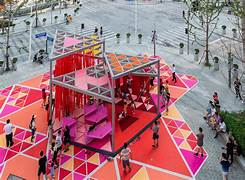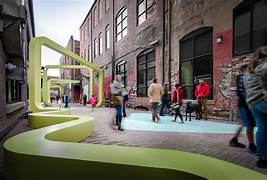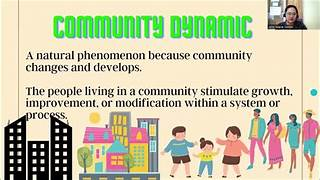The Intersection of Architecture and Art: How Creative Designs Transform Public Spaces
Introduction
Public spaces are more than just functional areas within our cities—they are vibrant canvases where art and architecture converge to create dynamic and engaging environments. This intersection of architecture and art can transform ordinary spaces into extraordinary ones, enriching urban life and fostering a sense of community. This blog explores how creative designs in architecture and art work together to redefine public spaces.
The Synergy Between Architecture and Art
Defining the Intersection:
Architecture provides the structural framework of public spaces, while art injects personality, meaning, and aesthetic appeal. When these disciplines collaborate, the result is a harmonious blend that enhances the functionality and visual impact of spaces.
Collaborative Design Process:
Architects and artists often work together from the early stages of a project, ensuring that artistic elements are seamlessly integrated into the architectural design. This collaboration can lead to innovative solutions that both serve practical purposes and contribute to the aesthetic experience.
Examples of Artistic Integration in Public Spaces
1. The High Line (New York City, USA):
This elevated park is a prime example of how art and architecture can blend to transform an unused industrial structure into a vibrant public space. The High Line features curated art installations, creative landscaping, and thoughtful architectural elements that create a unique urban experience.
2. Sydney Opera House (Sydney, Australia):
Renowned for its iconic sail-like design, the Sydney Opera House exemplifies how architectural forms can be both functional and artistic. The building itself is a masterpiece that has become a symbol of Sydney and a canvas for light-based art installations.
3. The Guggenheim Museum (Bilbao, Spain):
Designed by Frank Gehry, the Guggenheim Museum is celebrated for its sculptural architecture, which itself is a work of art. The building’s innovative design has transformed Bilbao into a cultural hub and demonstrates how architecture can become an integral part of the art experience.
4. The Eden Project (Cornwall, UK):
This ecological park features geodesic domes and a diverse array of plant life within an artistic framework. The design combines sustainability with striking visual aesthetics, creating a space where art and architecture celebrate environmental awareness.
Benefits of Artistic Integration in Public Spaces
Enhanced Aesthetic Appeal:
Artistic elements in public spaces make environments more visually stimulating and engaging. This can elevate the overall experience for users and contribute to the cultural identity of a location.
Fostering Community and Engagement:
Creative public spaces can become community focal points, encouraging interaction and participation. Art installations and architectural features often serve as landmarks or gathering spots, fostering a sense of belonging.
Promoting Cultural and Social Awareness:
Art in public spaces can reflect and celebrate cultural diversity, address social issues, and provoke thought. It creates opportunities for dialogue and reflection within the community.
Economic and Tourism Benefits:
Unique and visually striking public spaces attract tourists and can boost local economies. Iconic designs and art installations become points of interest, drawing visitors and generating revenue for surrounding businesses.
Challenges and Considerations
Balancing Functionality and Aesthetics:
While integrating art into public spaces, it's crucial to ensure that functional needs are not compromised. The design must meet practical requirements while also providing artistic value.
Maintenance and Longevity:
Artistic elements may require ongoing maintenance to preserve their appearance and functionality. Planning for long-term upkeep is essential to ensure that these spaces remain enjoyable and relevant.
Inclusivity and Accessibility:
Art and architecture should be inclusive and accessible to all members of the community. Design considerations must account for diverse needs and ensure that spaces are welcoming and usable by everyone.
Conclusion
The intersection of architecture and art offers a powerful means of transforming public spaces into vibrant, engaging environments. By thoughtfully integrating artistic elements with architectural design, we can create spaces that not only serve functional purposes but also enrich the cultural and social fabric of our communities. Embracing this synergy can lead to innovative, beautiful, and meaningful public spaces that enhance urban life and foster a deeper connection between people and their surroundings.




















![Terry Farrell [ British architect]](https://blogger.googleusercontent.com/img/b/R29vZ2xl/AVvXsEgF5Bc7-F6oyGHwVlcJfUVoN9PAph8ZIAQAVTMDZ0oOX0kIENEGN84Arj8wxKS666_yV2hRHMM4zlJ5gCJFBA1ttvrGBPrCNY0tZWfcuPl0aolt_szKpBjWtbLYutI4ivHBLrzZkj-wEk_l_1paoEEVkgnzCt7yvpHoDkhm63TxHxL45GUgV2OZVkwLYkWG/w100/11e81b6d-862f-4a23-a2d0-950d22063de0.png)



0 Comments